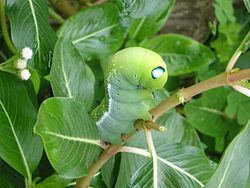- Deilephila
-
Deilephila 
Elephant hawk moth Scientific classification Kingdom: Animalia Phylum: Arthropoda Class: Insecta Order: Lepidoptera Family: Sphingidae Genus: Deilephila
Laspeyres, 1809[1]Species Deilephila elpenor
Deilephila porcellus
Deilephila rivularis
Deilephila nerii
Deilephila askoldensisSynonyms - Choerocampa Duponchel, 1835
- Cinogon Butler, 1881
- Dilephila Hampson, 1893
- Dilephila Kuznetsova, 1906
- Dilophila Agassiz, 1846
- Elpenor Agassiz, 1846
- Elpenor Oken, 1815
- Eumorpha Hübner, 1806
- Metopsilus Duncan, 1836
The genus Deilephila is part of the family Sphingidae, the hawk-moths or sphinxes. It consists of a small number of species most of which have common names involving the phrase "Elephant hawk moth". They include the Elephant hawk moth, Deilephila elpenor, the Small Elephant Hawk Moth (D. porcellus) and the Chitral Elephant Hawk Moth (D. rivularis). The Oleander Hawk Moth is sometimes classified in this genus as D. nerii, but sometimes treated in genus Daphnis.
The adults are quite similar to those of the related and larger genus Hyles. However their eyelashes are much more distinct, and the numerous spines on their abdomens are less strongly chitinized. They lay pale glossy green eggs. The larvae are not typical of hawk moth caterpillars, with the horn on the terminal segment being less pronounced than usual, and absent in some species. The head and thorax segments can be retracted into the first and second segments of the abdomen, which then appear enlarged and display eye-spots.
The caterpillars feed mainly on plants of the Willowherb and Bedstraw families (Onagraceae and Rubiaceae) families.
References
- ^ "CATE Creating a Taxonomic eScience - Sphingidae". Cate-sphingidae.org. 2009-07-21. http://www.cate-sphingidae.org/taxon/d7e50055-6bf4-1014-884b-8757473e38d3/relationsToThisTaxon.html. Retrieved 2011-10-26.
This Macroglossini-related article is a stub. You can help Wikipedia by expanding it.

